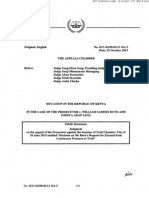Talvar ASS
Talvar ASS
Uploaded by
Muhammad Atif ArslanCopyright:
Available Formats
Talvar ASS
Talvar ASS
Uploaded by
Muhammad Atif ArslanOriginal Title
Copyright
Available Formats
Share this document
Did you find this document useful?
Is this content inappropriate?
Copyright:
Available Formats
Talvar ASS
Talvar ASS
Uploaded by
Muhammad Atif ArslanCopyright:
Available Formats
Assignment
"Talvar" movie analysis
Submitted by Muhammad Zunair T/SI
Beret # 50/2
"Talvar" was a Hindi film released in 2015, directed by Meghna Gulzar. It is based on the real-life 2008
Noida double murder case, in which a teenage girl, Aarushi Talwar, and the family's domestic help,
Hemraj Banjade, were found murdered in their home.
The movie presents multiple perspectives and interpretations of the case, highlighting the flaws and
inconsistencies in the investigation process. Here are some of the drawbacks portrayed in the film:
Drawbacks in the investigation process:
1. Contamination of the Crime Scene:
One major drawback was the contamination of the crime scene by the police and media
personnel. The lack of proper protocols and training resulted in crucial evidence being
compromised or lost, making it difficult to establish the truth.
2. Inadequate Forensic Analysis:
The film highlights the lack of thorough forensic analysis and proper collection of evidence. The
initial investigation failed to take into account crucial forensic aspects like fingerprints, blood
splatter analysis, and DNA testing, which could have provided vital clues.
3. Mismanagement of Evidence:
The mishandling and misplacement of evidence by the investigating officers further
compromised the case. This included the loss of the murder weapon, the golf club, and the
tampering of other significant pieces of evidence.
4. Inconsistent Statements and Conflicting Narratives:
The film highlights the contradictory statements given by various witnesses and suspects during
the investigation. The police failed to properly cross-examine and verify these statements,
leading to confusion and the possibility of false narratives.
5. Bias and Prejudice:
The movie portrays the influence of media sensationalism and public perception on the
investigation. The police were under immense pressure to solve the case quickly, leading to
biases and tunnel vision. They focused on Aarushi's parents as the prime suspects, neglecting
other potential leads and suspects.
6. Lack of Professionalism and Interdepartmental Conflict:
The film portrays the lack of coordination and professionalism among the various investigative
agencies involved in the case. The police, forensic experts, and the Central Bureau of
Investigation (CBI) had conflicts of interest and failed to work together effectively, hindering the
investigation.
Overall, it raises questions about the fairness, objectivity, and competence of the authorities involved,
ultimately leaving the audience to contemplate the true nature of justice in such complex cases.
You might also like
- Jury Duty - EditedDocument3 pagesJury Duty - EditedDonvine Mugendi100% (3)
- The Psychology of Spies and Spying: Trust, Treason, TreacheryFrom EverandThe Psychology of Spies and Spying: Trust, Treason, TreacheryNo ratings yet
- Forensics in Jessica Lal Murder Case - A Critical AnalysisDocument14 pagesForensics in Jessica Lal Murder Case - A Critical AnalysisAshok UpadhyayNo ratings yet
- Nourhan Habib - Forensic Psychology - Curtis FlowersDocument14 pagesNourhan Habib - Forensic Psychology - Curtis FlowersSima Habib100% (1)
- Blood, Powder, and Residue: How Crime Labs Translate Evidence into ProofFrom EverandBlood, Powder, and Residue: How Crime Labs Translate Evidence into ProofRating: 4 out of 5 stars4/5 (1)
- Reid TechniqueDocument270 pagesReid Techniquekayglower100% (3)
- The Realities of Criminal ProfilingDocument7 pagesThe Realities of Criminal Profilingapi-532631691No ratings yet
- Crime Scene Investigation of Talvar CaseDocument9 pagesCrime Scene Investigation of Talvar CaseVidhisha AgrawalNo ratings yet
- Eyewitness Testimony Is Not Always AccurateDocument7 pagesEyewitness Testimony Is Not Always AccuratejaimieNo ratings yet
- When They See UsDocument6 pagesWhen They See UsJarell HallmonNo ratings yet
- Rashomon Final EssayDocument8 pagesRashomon Final Essayuniversity jglsNo ratings yet
- In Adversarial SystemsDocument3 pagesIn Adversarial SystemsashishNo ratings yet
- Jamal Francique Cli Interim Report Final 5 3 21Document46 pagesJamal Francique Cli Interim Report Final 5 3 21api-513915846No ratings yet
- Prompt 1: Pre-Disposing Factors Promoting Institutional CynicismDocument4 pagesPrompt 1: Pre-Disposing Factors Promoting Institutional CynicismAllan OnyangoNo ratings yet
- English Part 2 TestDocument4 pagesEnglish Part 2 TestOscar PerezNo ratings yet
- Criminal Profiling and Insider Cyber CrimeDocument7 pagesCriminal Profiling and Insider Cyber CrimeYans PangerunganNo ratings yet
- Lexington Detective Lies To Grand Jury Case Regarding Police Officer S DeathDocument6 pagesLexington Detective Lies To Grand Jury Case Regarding Police Officer S DeathChristopher Alan HigniteNo ratings yet
- School Violence FBIDocument6 pagesSchool Violence FBISheila Mae BuenavistaNo ratings yet
- People v. Teehankee, Jr.Document2 pagesPeople v. Teehankee, Jr.Bnl NinaNo ratings yet
- Ethical Issues in Documentary FilmmakingDocument5 pagesEthical Issues in Documentary FilmmakingSonia Ji100% (1)
- Ek Ruka Hua FaislaDocument3 pagesEk Ruka Hua FaislaAnshuman AgarwalNo ratings yet
- Aarushi TalwarDocument3 pagesAarushi TalwarNafiahNo ratings yet
- Ballistics MM ReportDocument7 pagesBallistics MM Reportpoorna chandraNo ratings yet
- 12 Angry Men QuestionsDocument2 pages12 Angry Men QuestionsShakilMirza100% (1)
- Rashomon Final EssayDocument8 pagesRashomon Final Essayuniversity jglsNo ratings yet
- Damodaram Sanjivayya National Law University Sabbavaram, Visakhapatnam, A.P., IndiaDocument13 pagesDamodaram Sanjivayya National Law University Sabbavaram, Visakhapatnam, A.P., Indiavalluri viswanadhamNo ratings yet
- 12 Angry MenDocument4 pages12 Angry MenFrancesca Marina100% (1)
- Jessica Lal Murder CaseDocument15 pagesJessica Lal Murder Case21010125366No ratings yet
- Criminal EvidenceDocument7 pagesCriminal EvidenceShahrukh ShahNo ratings yet
- Murder Case Research PaperDocument8 pagesMurder Case Research Paperafedpmqgr100% (1)
- CSI Effect PaperDocument6 pagesCSI Effect PaperDanelya ShaikenovaNo ratings yet
- A Critical Analysis of Twelve Angry MenDocument5 pagesA Critical Analysis of Twelve Angry MenJustine Mwambi MichomaNo ratings yet
- Testimony of DujuanDocument4 pagesTestimony of Dujuanflysa6000No ratings yet
- True DetectiveDocument5 pagesTrue Detectivezazankhan19No ratings yet
- GUINILING Case AnalysisDocument12 pagesGUINILING Case AnalysisRosh MaduroNo ratings yet
- Investigative Report PPT FinalDocument24 pagesInvestigative Report PPT FinalDivya Chetan GohelNo ratings yet
- Sollers Final Report 2-9-2013Document238 pagesSollers Final Report 2-9-2013kevinhornepsu100% (1)
- Introduction to Law 2021 Lecture 8 Miscarriages of justice and the integrity of the rule of law-2Document54 pagesIntroduction to Law 2021 Lecture 8 Miscarriages of justice and the integrity of the rule of law-2xxcaliscrizlexxNo ratings yet
- Psychology Question:: Q) A Series of High Profile Armed Robberies Have Been Committed in A TownDocument1 pagePsychology Question:: Q) A Series of High Profile Armed Robberies Have Been Committed in A TownToby HudsonNo ratings yet
- Assignment One With CommentaryDocument12 pagesAssignment One With CommentaryAvemula1No ratings yet
- Ted Bundy MisidentificationDocument7 pagesTed Bundy Misidentificationmike.enovartsNo ratings yet
- AARUSHIDocument5 pagesAARUSHINafiahNo ratings yet
- Samaria Rice Second Letter To County ProsecutorDocument3 pagesSamaria Rice Second Letter To County ProsecutorsandydocsNo ratings yet
- Forensics - People v. Teehankee Jr.Document3 pagesForensics - People v. Teehankee Jr.Cardenas JusterNo ratings yet
- arushi hemraj murderDocument7 pagesarushi hemraj murderdevipriyasakala2002No ratings yet
- Rudwan MediaCriticDocument2 pagesRudwan MediaCriticjponNo ratings yet
- Criminal FacesDocument7 pagesCriminal FacesPavan RamakrishnaNo ratings yet
- Sowmya Nagory - 22010538 - 12 Angry Men ReviewDocument4 pagesSowmya Nagory - 22010538 - 12 Angry Men Reviewsowmyanagory10No ratings yet
- Can forensic evidences lead to miscarriages of justiceDocument13 pagesCan forensic evidences lead to miscarriages of justiceanawmeNo ratings yet
- Hostile Witness In DetailDocument10 pagesHostile Witness In DetailSanthoshAKNo ratings yet
- Analysis of Memory and Eyewitness Testimony in Witness For The DefenseDocument15 pagesAnalysis of Memory and Eyewitness Testimony in Witness For The Defenseweatethesea100% (1)
- CRIM UNIT 3 AC1.3Document7 pagesCRIM UNIT 3 AC1.3belldylan681No ratings yet
- Crimnology Section 3Document13 pagesCrimnology Section 3Ahmad Faraz VirkNo ratings yet
- Arnold Report Synopsis - Investigation Into Byrnes Mill MO Police Department.Document2 pagesArnold Report Synopsis - Investigation Into Byrnes Mill MO Police Department.JC PenknifeNo ratings yet
- 12 Angry Men ReportDocument8 pages12 Angry Men ReportMhmd KouriNo ratings yet
- CD101 Lesson 2Document35 pagesCD101 Lesson 2christiandaveescolasticoNo ratings yet
- Lou and Jonbenet: A Legendary Lawman's Quest to Solve a Child Beauty Queen's MurderFrom EverandLou and Jonbenet: A Legendary Lawman's Quest to Solve a Child Beauty Queen's MurderRating: 4 out of 5 stars4/5 (1)
- Canal FallsDocument20 pagesCanal FallsRajesh KhadkaNo ratings yet
- Teleparallelism - WikipediaDocument30 pagesTeleparallelism - WikipediaHusnain Ali wajidNo ratings yet
- Case Study 1Document4 pagesCase Study 1Arafat SanyNo ratings yet
- The Importance of Biodiversity Conservation For Environmental SustainabilityDocument4 pagesThe Importance of Biodiversity Conservation For Environmental SustainabilityRaj 147No ratings yet
- Certificates - Maam NoraDocument7 pagesCertificates - Maam NoraHEERAN PERONANo ratings yet
- Dear Candidate,: TH THDocument9 pagesDear Candidate,: TH THAkankshaNo ratings yet
- UNIT-2, 8-ChaudfroidDocument3 pagesUNIT-2, 8-ChaudfroidSUGATA NAYAKNo ratings yet
- Comparative QuestionDocument24 pagesComparative QuestionRanjeet Singh KushwahaNo ratings yet
- ZLJ5420JQZ55V Truck Crane Spare Parts Catalog: Edition 1 4,2015Document30 pagesZLJ5420JQZ55V Truck Crane Spare Parts Catalog: Edition 1 4,2015ismael50% (2)
- Payroll System With AttendanceDocument15 pagesPayroll System With Attendancearkis hamranNo ratings yet
- Jonathan Orot (CPM)Document92 pagesJonathan Orot (CPM)BlackFlameNo ratings yet
- DAH 122 PART A Question PaperDocument3 pagesDAH 122 PART A Question PaperBashyam Nageswara ReddyNo ratings yet
- Decision On Kenya's Deputy President MR William Ruto's Request For Excusai From Continuous Presence at TrialDocument27 pagesDecision On Kenya's Deputy President MR William Ruto's Request For Excusai From Continuous Presence at TrialJournalists For JusticeNo ratings yet
- Crim Pro Cases On Preliminary Investigation & ArrestDocument114 pagesCrim Pro Cases On Preliminary Investigation & ArrestNC BergoniaNo ratings yet
- Succesful Filipino Business EntreprenuerDocument7 pagesSuccesful Filipino Business EntreprenuerLiana CanizaresNo ratings yet
- Best Digital Marketing Company in MohaliDocument5 pagesBest Digital Marketing Company in MohaliWebitrex SolutionsNo ratings yet
- A Zaidi Manual of Hisbah of The 3rd Cent, Author(s) R. B. SerjeantDocument35 pagesA Zaidi Manual of Hisbah of The 3rd Cent, Author(s) R. B. SerjeantZaydi LibraryNo ratings yet
- CASE STUDY-Functional and Non FunctionalDocument3 pagesCASE STUDY-Functional and Non Functionalnitin10685No ratings yet
- Final Coaching-Plumbing CodeDocument13 pagesFinal Coaching-Plumbing Coderyancsalcedo061586No ratings yet
- MMS - Compliance Annexure - 1,2,3Document5 pagesMMS - Compliance Annexure - 1,2,3SatNo ratings yet
- Manual T53 T70Document123 pagesManual T53 T70Stuart GrantNo ratings yet
- De MantraDocument4 pagesDe Mantraanishokm2992No ratings yet
- Canada - Sec.1 - SummDocument3 pagesCanada - Sec.1 - Summjahira padillaNo ratings yet
- Vedant ResumeDocument1 pageVedant Resumeameywani2012No ratings yet
- Normal 61aa72c90fc9eDocument5 pagesNormal 61aa72c90fc9eAsia SlevinNo ratings yet
- Order On Motion To DisqualifyDocument23 pagesOrder On Motion To DisqualifyAaron Parnas100% (4)
- ADAM & KUAH (Chapter.1)Document35 pagesADAM & KUAH (Chapter.1)Behaviour Revolution100% (6)
- Material Distributors v. NatividadDocument7 pagesMaterial Distributors v. NatividadjrNo ratings yet
- Soal Latihan Kelas 10 SMK Bahasa InggrisDocument2 pagesSoal Latihan Kelas 10 SMK Bahasa Inggrisdwi watiNo ratings yet
- May2010 PDFDocument3 pagesMay2010 PDFJULIO CESARNo ratings yet

























































































